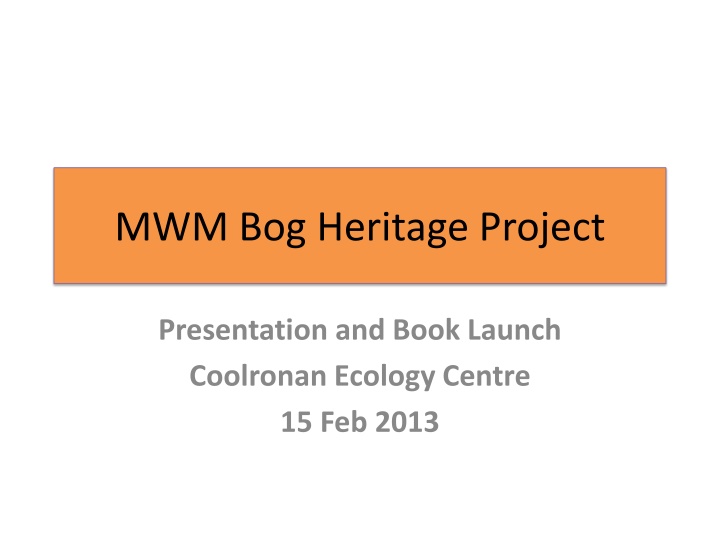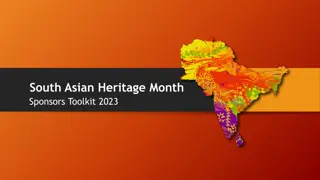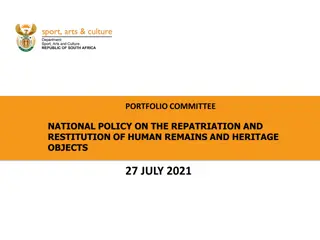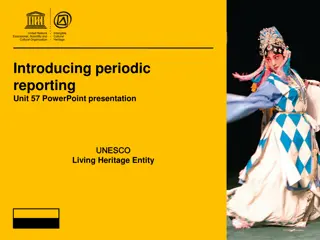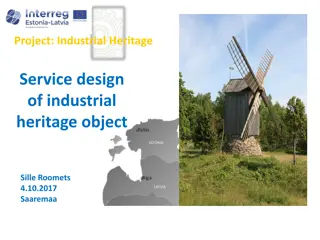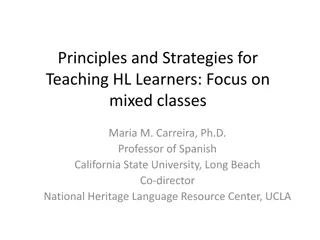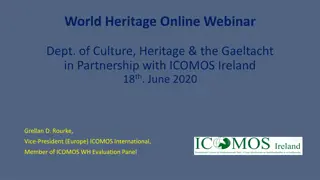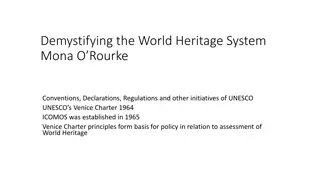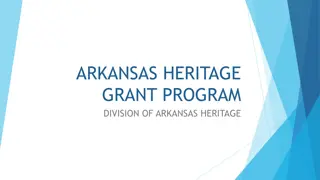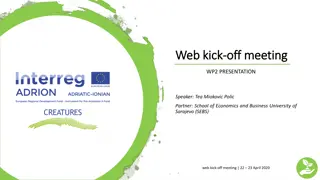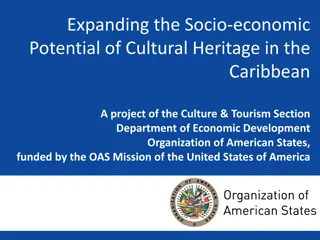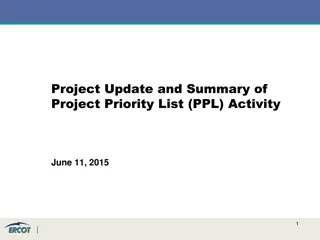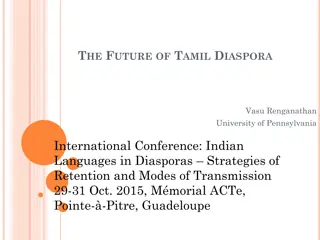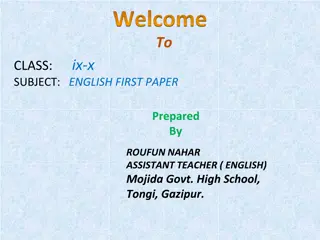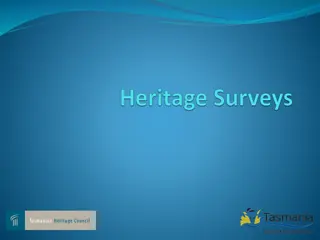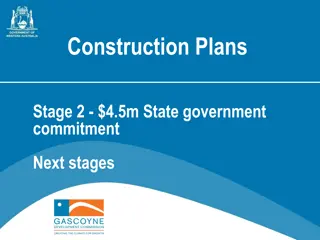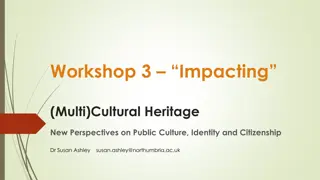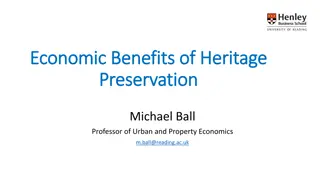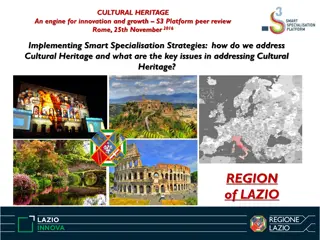MWM Bog Heritage Project Summary and Objectives
"The MWM Bog Heritage Project aims to develop a section of Ballivor bog for environmental and educational purposes, promote the area's heritage, and create employment opportunities. Objectives include creating an amenity area, preserving native plants and wildlife, and establishing a heritage and information center. The project involves collaboration with Bord Na Móna and community members to ensure the preservation and restoration of this unique ecosystem."
Download Presentation

Please find below an Image/Link to download the presentation.
The content on the website is provided AS IS for your information and personal use only. It may not be sold, licensed, or shared on other websites without obtaining consent from the author.If you encounter any issues during the download, it is possible that the publisher has removed the file from their server.
You are allowed to download the files provided on this website for personal or commercial use, subject to the condition that they are used lawfully. All files are the property of their respective owners.
The content on the website is provided AS IS for your information and personal use only. It may not be sold, licensed, or shared on other websites without obtaining consent from the author.
E N D
Presentation Transcript
MWM Bog Heritage Project Presentation and Book Launch Coolronan Ecology Centre 15 Feb 2013
Introduction This project was setup in Nov 2011 by a group of people in the locality. The project group is called MWM Bog Heritage Group (Meath/Westmeath) and is based here in this building called Coolronan Ecology Centre Thanks to Paul Nolan , Swan Inn proprietor for allowing the group to be located in this building lease free for the moment.
Objective Summary To develop an area within Bord Na Mona managed section of Ballivor bog as an amenity for the locality and for visitors. Develop this area within the bog where native bog plants and wildlife can flourish for both educational and environmental reasons To promote the heritage aspect of Ballivor bog for the interest of current and former residents of the area, and for the wider community To develop this building as a centre with information available on local heritage and environmental issues Bring some employment and business opportunities to the locality. This is a long-term objective
Objective 1 To develop an area within Bord Na Mona managed section of Ballivor bog as an amenity for the locality and for visitors. Ballivor Bog was a raised bog that comprises an area of 7,000 acres approx. Bord Na M na have ownership and control of 5,500 acres of the total. The project group have had discussions with Bord Na M na to section an area within the area of bog under their control to be sectioned off as part of a bog preservation and restoration project Also to facilitate walkways /access through the bog
Objective 2 Create an area within the bog where native bog plants and wildlife can flourish Native plants : Peat Forming Sphagnum Mosses ,Bog Bean, Deer Antler Lichen, Butterwort, Sundew, Bog Cotton, Bell + Ling Heather, Lichens, Cranberries, Bog Asphodel. Native Animals: Fox, Hare, Deer, Bat Native Amphibians: Otter, Newt , Common Frog Native Birds : Red Grouse, Corncrake, Curlew, Merlin , Lapwing, Hen Harrier, Skylark, Meadow, Pipit And many varieties of Invertebrates: Slugs, Spiders, Moths, and butterflies, Dragonflies, Damselflies ,Beetles (List compiled from IPCC website)
Objective 3 To develop the heritage aspect of Ballivor bog for the interest of current and former residents of the area, and for the wider community Plan to develop this building as a Bog Heritage and Information Centre The group has met with some senior members of the community to recall their recollections of growing up in and around Ballivor bog in 1940 s 1950 s and 1960 s and their stories have been noted. We will soon present these details on our website. One important landmark in the bog is ruin of the Brown family house. These recollections are part of the history of the locality and are invaluable to understand living and working in the bog
Objective 4 Bring some employment and business opportunities to the locality If the project proceeds as planned , there is an opportunity to support existing businesses in the locality eg Ground work contractors to develop walkways , removal of items dumped in bog. Also to assist re drainage work and developing areas of untouched and cutover sections of bog to develop sphagnum moss growth Also once the site is established shops, hotels, guesthouses ,minibus operators who would benefit by visitors to the area
Activities 2012 Activities to date include Creation of membership cards to cover costs such as stationery , public liability insurance etc Feb 2012 Creation of website www.mwmbogproject.com Feb 2012 Presentation to Ballivor Community and Renaissance Group March 2012 Visited headquarters of IPCC (Irish Peatland Conservation Council) in Lullymore, Co Kildare April 2012 Meetings with senior residents of Ballivor Bog May 2012 Meeting with Meath Leader archaeologist re house ruin and Cloneycavan Man June 2012 Meeting with environmentalist , Eanna Ni Lamhna June 2012
Activities To Date 2012 continued Meeting with Bord na Mona Feb , July 2012 Meeting with Meath Co Council Heritage Dept , Aug 2012 Meeting with NPWS to discuss wildlife Sept 2012 Attended Bog Regeneration course run by IPCC Sept 2012 Formal application to Meath Leader for funding Sept 2012 Facebook page creation Sept 2012 Approval from Meath Leader for this project to proceed Oct 2012 Meath Leader appointed project consultants commenced ecology survey of Ballivor bog , and organised funding application, Oct/Nov 2012 Attended Irish Peat Society seminar, Mayo Oct 2012
Activities To Date 2013 Guided walk , Ballivor Bog , Jan 1st 2013 Attended Bord Na Mona BioDiversity Action Plan Review Day, Lough Boora ,Co Offaly Jan 2013 Meeting with Bord Na Mona to review MWM Project objectives, Jan 2013 Newstalk FM Radio Presentation Jan 2013 Attended Hydrology course, Navan Feb 2013
Future Activities Planned Further guided walks , 2 more planned in 2013; one of these will be during Heritage Week Sun Aug 25th Wild Food Foraging Walk , July /Aug , forms available at desk Expand and add features to our membership , currently at over 100 ; forms available at desk Website content update ; pictures and videos; expand Facebook presence Get firm commitment from Bord Na Mona to allow the group to preserve and develop specific areas of Ballivor Bog Develop Heritage and Information centre in this building Visit centres around the country such as Clara and Abbeyleix to get further ideas on bog heritage and amenities Promote the study of bees and relationship to flora and fauna of a bog Present environmental awareness evenings in the centre eg Bees , climate issues , farming , woodlands etc
Flora and Fauna Bees Wetlands
Other Related Matters of Ballivor bog , only a section of Bord Na Mona bog as previously outlined. This project is not intruding on any privately owned parts The group is not opposed to private owners cutting turf develop and maintain The project is planned to be a long term one which will take time to
Uses for Irish Peatlands and their resources Animal Bedding Bird Watching Bog wood for carving Camping , Orienteering , Fishing Clay Pigeon Shooting Bog snorkelling Walking trails Peat smoking of fish & whisky Medicinal Plants , Heather honey Balneology , therapies (Ref Irish Peatland Conservation Council )
Amenity Activities Bird Watching Bog Tours Nature Trails Raised walkways
Items found in Irish Bogs Bog Oak Bog Butter Human remains Humour I lived in a bog for decades and didn't age a day. Unfortunately, I smelled like rotten peat moss the whole time and couldn't get a date in spite of my eternally youthful looks. In retrospect, it just wasn't worth the hassle Sometimes you can live in the bog too long
Functions of a bog Bogs develop under conditions of low temperature, high acidity, low nutrient supply, stagnant water, and oxygen deficiency. In addition to being a fuel source , bogs have other important functions filtering water ..water quality acting as a water collection basin drainage accumulating carbon environmental providing habitat for flora and fauna nature balance
Effects of Carbon emission Once a peat bog dries out, it starts emitting carbon by giving off carbon dioxide gas (CO2) and methane into the atmosphere, and by releasing it into rivers and streams in the form of dissolved organic carbon (DOC). Bogs hold staggering amounts of carbon - estimated at 455 petagrams, around a third of the world's stock of soil organic carbon. (1 Petagram = 1 Billion Metric Tonnes) If bogs lose more carbon as DOC, this could have serious effects on drinking water supplies. As well as turning water brown, dissolved carbon can interfere with treatment filters and make it more expensive to make water safe to drink. And if peat bogs become badly degraded, there could also be implications for the risk of flooding.
General Principles for Bog Restoration Identifying bogs for preservation through environmental assessment; Using careful harvesting techniques so that restoration can be readily achieved Leaving at least three feet of peat at the bottom of the bog Returning of harvested bogs to functioning wetlands
Example of Bog Restoration project In Abbeyleix Bog in 2009 , BNM worked with local community to restore water levels to promote peat forming vegetation In Abbeyleix, BNM worked with IPCC (Irish Peatland Conservation council) , IPWS (Irish Parks and Wildlife service) and Laois Heritage on this project. A lease agreement has been put in place with the local community that passes responsibility to local community to manage the bog there. This is the type of joint initiative that the MWM Bog Project has in mind to promote and sustain the bog.
End of Presentation www.facebook.com/pages/MWM-Bog- Project/18969444116467 mwmbogproject.com
